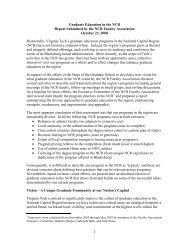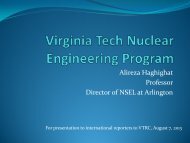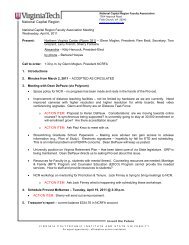1 - Nuclear Science and Engineering Lab (NSEL) - Virginia Tech
1 - Nuclear Science and Engineering Lab (NSEL) - Virginia Tech
1 - Nuclear Science and Engineering Lab (NSEL) - Virginia Tech
- No tags were found...
Create successful ePaper yourself
Turn your PDF publications into a flip-book with our unique Google optimized e-Paper software.
Advanced Hybrid Transport Methodologies forMedical Image Reconstruction in Real‐TimeProf. Alireza HaghighatDirector of VT 3 G & <strong>NSEL</strong><strong>Nuclear</strong> <strong>Engineering</strong> ProgramMechanical <strong>Engineering</strong> Department<strong>Virginia</strong> <strong>Tech</strong> Research Center (VTRC)Arlington, VAhaghighat@vt.eduPresented at the ANS‐ASME meeting, Lynchburg, VA, Dec 13, 2012<strong>Nuclear</strong> <strong>Engineering</strong>Program1
<strong>Virginia</strong> <strong>Tech</strong> <strong>Nuclear</strong> <strong>Engineering</strong> Program , VT‐NEP(regional, multidisciplinary)<strong>NSEL</strong> @ VTRC, Arlington<strong>Nuclear</strong> <strong>Science</strong> <strong>and</strong> <strong>Engineering</strong> <strong>Lab</strong> (<strong>NSEL</strong>) – Institute ofCritical <strong>Tech</strong>nology <strong>and</strong> Applied <strong>Science</strong> (ICTAS)NEP @ VT, Blacksburg<strong>Nuclear</strong> <strong>Engineering</strong> Program (NEP),Mechanical <strong>Engineering</strong> Department• Government agencies• industry• Medical centers• Universities engaged in nuclearpolicyCollege of <strong>Engineering</strong>College of <strong>Science</strong>College of Veterinary‐MedicineCollege of Arts <strong>and</strong> Human <strong>Science</strong>sCAER @ LynchburgCenter for Advanced <strong>Engineering</strong> Research (CAER) –A partnershipof State of VA, industry <strong>and</strong> Universities<strong>Nuclear</strong> <strong>Engineering</strong>ProgramAREVAB&WUVA, VT, VCU2
Status of VT‐NEP• 5 Core faculty• Haghighat (Particle transport methods <strong>and</strong> their application in power, medicine<strong>and</strong> security, design of non‐destructive detection <strong>and</strong> imaging systems, reactordigital I&C, severe reactor accidents )• Hin (<strong>Nuclear</strong> <strong>and</strong> Thermoelectric Materials Modeling)• Liu (Reactor Thermal Hydraulics <strong>and</strong> Safety)• Pierson (<strong>Nuclear</strong> fuel cycle, Reactor operations <strong>and</strong> instrumentation, nuclearsecurity <strong>and</strong> non‐proliferation, radiation detection)• Winfrey (Plasma physics, materials fabrication <strong>and</strong> evaluation, <strong>and</strong> fusion)• 8 Affiliate faculty [Battaglia (ME ‐ CFD), Brown (ME‐CFD/MD), Farkas (MSE‐Materials), Hendricks (MSE‐Materials), Kulkarni (ESM‐<strong>Nuclear</strong> nonproliferation<strong>and</strong> policy), Mahajan (ME‐Materials), Tafti (ME‐CFD) & Schmid(STS‐<strong>Nuclear</strong> policy)]• 1 Adjunct faculty [Turso (Northrop Grumman – Reactor Control]• NEP faculty has initiated/established multi‐disciplinary activities in differentapplications of <strong>Nuclear</strong> <strong>Science</strong> <strong>and</strong> <strong>Engineering</strong> including:power, safeguards <strong>and</strong> non‐proliferation, medicine, & policy<strong>Nuclear</strong> <strong>Engineering</strong>Program3
<strong>Nuclear</strong> Theory, experiment, <strong>and</strong> Computation: (Haghighat, Liu, Pierson <strong>and</strong> Winfrey,Battaglia, Tafti, <strong>and</strong> Brown, plus 1-2 hires)Hybrid particle transport methods <strong>and</strong> their application to nuclear systems, High performancecomputing, multi-scale <strong>and</strong> multi-physics methodologies, <strong>and</strong> virtual visualization, High energydensity plasma modeling, Thermal hydraulics modeling, Computational methods in reactorphysics <strong>and</strong> shielding, perturbation methods<strong>Nuclear</strong> Safety, Security, Non-proliferation, <strong>and</strong> Safeguards: (Haghighat,Kulkarni & Pierson, Schmid plus 1-2 new hires)Nonproliferation, Radiation protection <strong>and</strong> shielding, <strong>Nuclear</strong> fuel cycle management, <strong>Nuclear</strong>waste disposal, <strong>Science</strong>-based analysis <strong>and</strong> support of nuclear policy formation<strong>Nuclear</strong> Materials Research: (Farkas, Hendricks, Clark, <strong>and</strong> Hin, plus 1-2 new hires)Novel nuclear materials design, Thermoelectric materials, Materials modeling <strong>and</strong> simulation,Hard coatings, plasma-material interactions<strong>Nuclear</strong> Fuel Cycle: (Pierson, Clark, Hin, Haghighat, plus 1-2 new hire)Fuel design <strong>and</strong> modeling, used nuclear fuel processing, waste forms, waste disposition, MaterialProtection Accounting <strong>and</strong> Control <strong>Tech</strong>nologies (MPACT)<strong>Nuclear</strong> Power Operations: (Pierson & Haghighat, plus 1-2 new hires)Design of digital instrumentation <strong>and</strong> control, Alternative reactor technology, Reactor operations<strong>and</strong> safetyEmerging <strong>Nuclear</strong> <strong>Tech</strong>nologies: (Haghighat, Mahajan & Winfrey, plus1-2 new hire)Design of nondestructive detection systems, New methods of medical imaging, Fusion reactorfueling Nano-nuclear science<strong>Nuclear</strong> <strong>Engineering</strong>Program4
• Leadership: Haghighat, Kulkarni & Farkas• Activities:• Teaching (within the regional triangle)• NSEG 5124 (<strong>Nuclear</strong> Reactor Analysis); NSEG 5134 (Monte Carlo Method); & NSEG 6124(Advanced <strong>Nuclear</strong> Reactor Analysis); ESM 6984 (S&T <strong>and</strong> Policy –Their Interplay);<strong>Nuclear</strong> Security: Nonproliferation <strong>and</strong> Safeguards," NSEG (or ME)/STS 5984; InCollaboration with UT, developing a course on Digital I&C (funded by NRC)• Research – <strong>Virginia</strong> <strong>Tech</strong> Transport Theory Group, VT 3 G• <strong>Nuclear</strong> power• <strong>Nuclear</strong> non‐proliferation <strong>and</strong> safeguards• Medicine• Seeking collaborations• Other VT faculty members, <strong>and</strong> NCR universities, government agencies <strong>and</strong>private organizations• Initiating new activities• Contribution to formulation of <strong>Nuclear</strong> policy, Public engagement, Emergencyresponse to nuclear events• Organizing seminars/workshops/symposia/forums• Nov 7‐11, 2011, 13 th international workshop on particle transport methodologies(www.cpe.vt.edu/lpcf)• June 2013, 14 th international workshop on particle transport methodologies• March 12, 2012 ‐ A Symposium on Low Power Critical Facilities, sponsored by SUNRISE(Southeast Universities <strong>Nuclear</strong> Reactors Institute for <strong>Science</strong> <strong>and</strong> Education)(www.ictas.vt.edu/nuclear)• Nov. 5, 2012 ‐ A Forum on <strong>Nuclear</strong> Regimes: Future Outlook<strong>NSEL</strong> at Arlington<strong>Nuclear</strong> <strong>Engineering</strong>Program5
VT‐NEPFuture• Finalize MS <strong>and</strong> PhD degrees in <strong>Nuclear</strong> <strong>Engineering</strong> ‐under review by SCHEV• Increase the size of Core faculty to 8‐12• Establish a School <strong>Nuclear</strong> <strong>Engineering</strong> & <strong>Science</strong>(SNES) <strong>and</strong>/or <strong>Nuclear</strong> <strong>Engineering</strong> Department<strong>Nuclear</strong> <strong>Engineering</strong>Program6
What is Particle Transport Theory?Determination of the expected number (average) ofparticles in a phase space (dVdEd) at time t:n ( r , E,ˆ, t)dvdEdzdvdΩΩdEryxTo determine particle flux, current, <strong>and</strong> reaction rates.<strong>Nuclear</strong> <strong>Engineering</strong>Program 7
Simulation Approaches• Deterministic Methods• Solve the linear Boltzmann equation to obtain the expected flux in aphase space• Statistical Monte Carlo Methods• Perform particle transport experiments in a r<strong>and</strong>om manner on acomputer to estimate average behavior of a particle in phase space<strong>Nuclear</strong> <strong>Engineering</strong>Program8
Deterministic – Linear Boltzmann Equationˆ ˆ .(r,E,)( r,E)(r,E,ˆ) streamingdE'0 4(E)4d' ( r,E'dE's0 4scatteringfissiond'fcollisionˆ ˆ E,' )(r,E',ˆ) Indp. source ˆ ( r,E)(r,E',) S(r,E,ˆ)<strong>Nuclear</strong> <strong>Engineering</strong>Program 9
Integro-differential – Discretized formulation• Discretized angular variable – DiscreteOrdinates (Sn) method: considering aconservation criteria,ˆmA set of { ˆ , w m } obtained, <strong>and</strong>.m ˆ . ( , , ) ( , ) ( , , ˆ r E r E r E ) q(r,E,ˆmmm), m=1, M0.20.4V20.60.8110.80.6V10.40.2X10000• Discretized spatial variable:Integrated over fine meshes using Finite Volume or FEmethodsm,g,AVdVijkg ( r ) m,gVijk( r )• Discretized energy variable:Multigroup approach: Energyrange, e.g., [0, 20 MeV], ispartitioned into G groups,g=5g=4g=3g=2g=1Where,<strong>Nuclear</strong> <strong>Engineering</strong>Program 10
Monte Carlo Methods• Perform an experiment on a computer; “exact”simulation of a physical processPathlengthr lntType ofcollision stScattering angle(isotropicscattering)0 21SampleS (r, E, Ω)absorbedabsorbedabsorbedTally (count)Variance Reduction techniques are need for real‐world shielding problems!<strong>Nuclear</strong> <strong>Engineering</strong>Program11
Deterministic vs. Monte CarloItem Deterministic MCGeometry Discrete/ Exact ExactEnergy treatment – DiscreteExactcross sectionDirection Discrete/ Truncated series ExactInput preparation Difficult simpleComputer memory Large SmallComputer time Small LargeNumerical issues Convergence Statistical uncertaintyAmount of LargeLimitedinformationParallel computing Complex Trivial<strong>Nuclear</strong> <strong>Engineering</strong>Program12
Therefore, hybrid methods are needed.What is “hybrid”?It is a combination ofDifferent forms of the LBEDeterministic <strong>and</strong>/or Monte Carlo approachesDifferent numerical techniques,Forward & Adjoint/Importance LBETime‐dependent & Time‐independent<strong>Nuclear</strong> <strong>Engineering</strong>Program13
<strong>Virginia</strong> <strong>Tech</strong> Transport Theory Group ‐ VT 3 GVisionTo be able to perform detailed 3‐D, timedependent,neutral‐ <strong>and</strong> charged‐particletransport calculation efficiently (computertime & engineer’s time) <strong>and</strong> accurately forapplication to power, safeguards <strong>and</strong>nonproliferation, <strong>and</strong> medicine<strong>Nuclear</strong> <strong>Engineering</strong>Program14
VT3G ‐Advanced Computer codes/Formulations/AlgorithmsOver the last 26 years, VT3G has developed numerousadvanced formulations <strong>and</strong> computer codes, <strong>and</strong> applied thesecodes to real-world problems.Advanced numerical formulations:Differencing schemes (DTW, EDW, ADS), Cross-section generation (CPXSD),angular quadrature (Pn-Tn, Ordinate Splitting, fictitious), acceleration scheme(EP-SSn), response function for subcritical multiplication, & hybrid techniquesTransport codes• PENTRAN (Parallel Environment Neutral-particle TRANSport) – A 3-D parallelparticle transport code, Sjoden <strong>and</strong> Haghighat, 1997.• A 3 MCNP – Automated Adjoint Accelerated MCNP for Monte Carlo neutral particletransport with automated variance reduction, Wagner <strong>and</strong> Haghighat, 1997.• TITAN –A 3-D Hybrid parallel transport code, Yi <strong>and</strong> Haghighat, 2007.• ADIES - Angular-dependent Adjoint Driven Electron-photon Importance Samplingfor Monte Carlo electron transport with automated variance reduction, Dionne <strong>and</strong>Haghighat, 2007.Cross-section generation code• CPXSD – Contributon Point-wise cross-section Driven for generation of arbitrarymultigroup cross-section librariesSpecialized Hybrid methods/algorithms/codes• TITAN-SPECT algorithm• INSPCT-S (inspection of spent fuel pool)• AIMS (Active Interrogation for Monitoring of Special-nuclear-materials) PENTRANstTITANADIES0 2 1AIMS ln r 5453 0.580498 0.561644 0.491674 0.420538 0.353999 0.28285 0.27647 0.897903 0.880437 0.770597 0.653747 0.543993 0.427576 0.38686 1.271323 1.252983 1.094413 0.922518 0.761393 0.591298 0.49337 1.696988 INSPCT‐S1.669344 1.453015 1.219392 1.002015 0.772365 0.59258 1.978009 1.923356 1.665877 1.394836 1.14574 0.880125 0.67336 1.093457 1.058167 0.914234 0.765146 0.628852 0.482792 0.3t<strong>Nuclear</strong> <strong>Engineering</strong>Program
Graduate studentsKatherine Royston, PhD c<strong>and</strong>idateNathan Roskoff, MS c<strong>and</strong>idateWilliam Walters, PhD c<strong>and</strong>idate&CollaborationsProfs. Petrovic, Rahnema & Sjoden, <strong>and</strong> Dr. Yi, Georgia <strong>Tech</strong>Prof. Upadhyaya, University of TennesseePlus a new contract led by Georgia <strong>Tech</strong> with collaborators from Univ. ofMichigan, Westinghouse, Univ. of Cambridge, Politecnico di Milano, INL,Univ of Idaho, Southern <strong>Nuclear</strong>, Morehouse CollegeRecruitmentSeeking graduate students <strong>and</strong> postdoctoral fellows<strong>Nuclear</strong> <strong>Engineering</strong>Program 16
<strong>Nuclear</strong> Power• Development of advanced multigroup algorithms forSimulation of Advanced Reactors (Funded by DOE–Jointwith Georgia <strong>Tech</strong>);• VT task: Developing an algorithm for TITAN• In collaboration with Prof. Upadhyaya from University ofTennessee is developing a course on digital I&C (fundedby NRC)• Neutronics Simulation in Support of mPower ReactorModeling (Funded by B&W mPower Generation);• Reactor core <strong>and</strong> ex‐core detector modeling <strong>and</strong> simulationin support of their licensing activities, <strong>and</strong> development ofeffective core monitoring.• Design of an Integral Inherently Safe LWR (I 2 S‐LWR)system (Recently funded by DOE – led by GT, include 9organizations, a budget of $6 M for three years);• VT task: Design an inherently safe spent fuel pool with onlinemonitoring system<strong>Nuclear</strong> <strong>Engineering</strong>Program
<strong>Nuclear</strong> non‐proliferation• Advanced hybrid algorithms fordevelopment of tools forinspection of shipping containers(Funded by NNSA ‐Joint withGeorgia <strong>Tech</strong>): VT task: Developedhybrid response functionmethodologies<strong>Nuclear</strong> Safeguards• Developed the INSPCT tool formonitoring of spent fuel pool(funded by LLNL)Monitoring of Spent Fuel PoolInspection of Containers for SNM† ( r , E , ˆ) SEstimated current alongcontainer depth0 10 20 30 40 50INPUTOUTPUTsrc file C:\Users\ali\Documents\haghD\ufttg\LLNL\INSPCT-s\se.dsrcINSPCT‐SCOLUMNS 8 fm file C:\Users\ali\Documents\haghD\ufttg\LLNL\INSPCT-s\seResponse Tolerance Detector NormalizationROWS 6 imp file C:\Users\ali\Documents\haghD\ufttg\LLNL\INSPCT-s\se 15.00% 5.28E-10runBurnupIndependent Source(x,y) 1 2 3 4 5 6 7 8 (x,y) 1 2 3 4 5 6 7 81 9000 9000 9000 9000 9000 9000 9000 9000 1 4.60E+07 3.39E+07 2.84E+07 2.48E+07 2.21E+07 1.94E+07 1.56E+07 130369482 10000 10000 10000 10000 10000 10000 10000 10000 2 6.89E+07 5.30E+07 4.49E+07 3.86E+07 3.39E+07 2.91E+07 2.26E+07 181016923 11000 11000 11000 11000 11000 11000 11000 11000 3 1.00E+08 8.04E+07 6.86E+07 5.84E+07 5.06E+07 4.29E+07 3.23E+07 250472564 12000 12000 12000 12000 12000 12000 12000 12000 4 1.42E+08 1.17E+08 1.01E+08 8.51E+07 7.33E+07 6.15E+07 4.53E+07 342048425 13000 13000 13000 13000 13000 13000 13000 13000 5 1.98E+08 1.67E+08 1.45E+08 1.22E+08 1.04E+08 8.67E+07 6.28E+07 464929946 14000 14000 14000 14000 14000 14000 14000 14000 6 2.68E+08 2.32E+08 2.01E+08 1.69E+08 1.44E+08 1.19E+08 8.52E+07 62072007Cooling timeFission Source(x,y) 1 2 3 4 5 6 7 8 (x,y) 1 2 3 4 5 6 7 81 1 2 5 10 15 20 30 40 1 4.03E+07 4.68E+07 4.25E+07 3.66E+07 3.11E+07 2.57E+07 1.98E+07 125211882 1 2 5 10 15 20 30 40 2 6.88E+07 8.12E+07 7.41E+07 6.34E+07 5.32E+07 4.33E+07 3.26E+07 201996393 1 2 5 10 15 20 30 40 3 9.82E+07 1.17E+08 1.07E+08 9.08E+07 7.54E+07 6.05E+07 4.47E+07 271698784 1 2 5 10 15 20 30 40 4 1.32E+08 1.58E+08 1.44E+08 1.21E+08 9.98E+07 7.93E+07 5.78E+07 347511345 1 2 5 10 15 20 30 40 5 1.62E+08 1.92E+08 1.73E+08 1.45E+08 1.19E+08 9.42E+07 6.80E+07 408239416 1 2 5 10 15 20 30 40 6 1.49E+08 1.74E+08 1.56E+08 1.30E+08 1.06E+08 8.38E+07 6.03E+07 36229288Response (experimental)Response(Calculated)(x,y) 0.5 1.5 2.5 3.5 4.5 5.5 6.5 7.5 8.5 (x,y) 0.5 1.5 2.5 3.5 4.5 5.5 6.5 7.5 8.50.5 0.5 0.123198 0.230998 0.221266 0.193583 0.166627 0.141523 0.114534 0.083892 0.0366111.5 0.6 0.3 1.5 0.305453 0.580498 0.561644 0.491674 0.420538 0.353999 0.28285 0.203871 0.0875992.5 0.8 2.5 0.467647 0.897903 0.880437 0.770597 0.653747 0.543993 0.427576 0.301569 0.1278193.5 3.5 0.658686 1.271323 1.252983 1.094413 0.922518 0.761393 0.591298 0.410909 0.1725544.5 1.4 4.5 0.879337 1.696988 1.669344 1.453015 1.219392 1.002015 0.772365 0.532245 0.2226165.5 1.2 5.5 1.029258 1.978009 1.923356 1.665877 1.394836 1.14574 0.880125 0.605581 0.2531926.5 6.5 0.57336 1.093457 1.058167 0.914234 0.765146 0.628852 0.482792 0.332139 0.139652dgnSlide10<strong>Nuclear</strong> non‐proliferation & safeguards<strong>Nuclear</strong> <strong>Engineering</strong>ProgramResponse Difference0.5 1.5 (x,y) 2.5 3.5 4.5 5.5 6.5 7.5 8.50.51.5 3.36% -15.25%2.5 3.82%3.54.5 -3.65%5.5 4.74%6.5
Slide11Medicine• Development of an image reconstruction algorithmfor SPECT (Single Phone Emission ComputedTomography); developed hybrid algorithms, to bediscussed in this presentation.<strong>Nuclear</strong> <strong>Engineering</strong>Program
TITAN Algorithm allows for the use of different algorithms,even Monte Carlo, in different coarse meshes.Sn Solver –coarse mesh( n)gijk2n 2n 2nxin y in z inQx y z2n 2n 2nijk x y z( n)gijkCM solver‐coarse meshoutginkginkin gisQink gingisinkginke (1 e )giinoutQgingink gink s gi ink gi A P BA B P B AB AA<strong>Nuclear</strong> <strong>Engineering</strong>Program 20B
TITAN Code SystemTITAN is a 3‐D, parallel code system with a hybridSn <strong>and</strong> Characteristics algorithm1. Written from scratch in Fortran 90 with somefeatures in Fortran 2003 st<strong>and</strong>ard, such asdynamic memory allocation <strong>and</strong> object orientedprogramming. (uses similar approach as PENTRAN)2. Compiled by Intel Fortran Compiler (ifc 8.0+) orPGI f90 compiler (pgf90 6.1), still underdevelopment, over 22,000 lines now<strong>Nuclear</strong> <strong>Engineering</strong>Program 21
Introduction to SPECT (Single Photon Emission Computed Tomography )Imaging Device• Functional imaging modalityInject aradioactivematerialExampleD~1.5 mmL=23 mmAspectratio=~15A projectionangleNotes• Limited image quality <strong>and</strong> spatial resolution• Traditionally simulated using Monte Carlo methods<strong>Nuclear</strong> <strong>Engineering</strong>Program
Goal•Simulation of the SPECT (Single PhotonEmission Computed Tomography) using accurate<strong>and</strong> fast hybrid deterministic formulation•Use simulation results for imageconstruction:• Improving the image quality• Reducing radioactive uptake<strong>Nuclear</strong> <strong>Engineering</strong>Program
Reference Model• A SPECT myocardial perfusion study with<strong>Tech</strong>necium‐99m (Tc‐99m) was simulated.• Tc‐99m is absorbed by the heart wall where it emits140.5 keV gamma rays.• The NURBS‐based cardiac‐torso (NCAT) code wasused to create a 64 x 64 x 64 voxel phantom with a Tc‐99m source in the heart wall.<strong>Nuclear</strong> <strong>Engineering</strong>Program
<strong>Nuclear</strong> <strong>Engineering</strong>ProgramNCAT voxel phantom
Multigroup cross sections for TITAN‣Energy group structureSince source energy is 140.5 keVEnergyGroupUpper Bound(keV)Lower Bound(keV)1 154.55 126.452 126.45 98.353 98.35 10‣Used CEPXS multigroup photon cross sections(S<strong>and</strong>ia National <strong>Lab</strong>oratories)<strong>Nuclear</strong> <strong>Engineering</strong>Program26
Discrete ordinatesXHow to model thecollimators?100000.20.20.40.4V20.60.80.80.6V111<strong>Nuclear</strong> <strong>Engineering</strong>Program27
TITAN Hybrid formulation for SPECT simulationStep 4 – Ray‐tracingfor transport throughthe collimatorStep 3 – Snwithfictitious quadratureStep 2 – Selectfictitious directionsStep 1 – SnCalculation<strong>Nuclear</strong> <strong>Engineering</strong>Program28
Step 2 – Selection of fictitious directionsParticles blocked byCollimatorPhantomDetectorAcceptance angle‣Solve for angular fluxalong directions withinacceptance angleProjectionangleCircular Splitting<strong>Nuclear</strong> <strong>Engineering</strong>Program29
Step 3 –Snwith fictitious direction• To calculate angular fluxes along directions ofinterest, TITAN Sn algorithm is modified for treatinga fictitious quadrature set• Fictitious quadrature represents all the projection angles<strong>and</strong> directions created through circular splitting<strong>Nuclear</strong> <strong>Engineering</strong>Program30
Step 3 ‐ Sn with Fictitious Quadrature• To calculate the angular flux for the fictitiousquadrature set on the surface of the phantom, wedeveloped the following algorithm:• Obtain flux moments from step 1• Calculate Scattering Source for Extra Sweep along fictitiousquadrature set• Perform an extra sweep to obtain angular flux along thefictitious quadrature set.<strong>Nuclear</strong> <strong>Engineering</strong>Program31
Step 4 –Ray tracing along collimators• Since the spatial meshing of the phantom is much coarser than thecollimator opening• The characteristic rays are drawn from each pixel of the projection imagebackward to the phantom surface along the projection angle <strong>and</strong> thesplit directions circularly surrounding it• Using a bi‐linear interpolation procedure, angular fluxes along theprojection angle <strong>and</strong> its split directions are determine• Using a ray‐tracing formulation through vacuum ‐ particles leavingthe phantom surface are transported through a set of collimatorsnormal to the SPECT camera.• The intensity of each pixel in the projection images is evaluated bythe integration of the angular flux at that pixel over the smallcollimator acceptance angle.<strong>Nuclear</strong> <strong>Engineering</strong>Program
Collimator CasesCaseAcceptanceAngleAspect Ratio1 2.97° 9.52 1.42° 20.13 0.98° 29.3<strong>Nuclear</strong> <strong>Engineering</strong>Program33
Collimator Case 3 (0.97º)Anterior Projection Images(Based on 1 st energy group)TITANMCNP5<strong>Nuclear</strong> <strong>Engineering</strong>Program34
Maximum difference of TITAN results relative to MCNP5results * in the heart for each collimator caseCaseNumberAcceptance Angle(degrees)Maximum RelativeDifference (%)1 2.97 21.32 1.42 11.93 0.98 8.3*All MCNP5 data had 1‐ uncertainty 3% in the heart<strong>Nuclear</strong> <strong>Engineering</strong>Program35
Profiles through column 44 ofprojection images<strong>Nuclear</strong> <strong>Engineering</strong>Program
Profiles through row 33 ofprojection images<strong>Nuclear</strong> <strong>Engineering</strong>Program
TimingCaseNumberAcceptanceAngle(degrees)MCNP5(min)*CodeTITAN(min) †SpeedupFactor(MCNP5/TITAN)1 2.97 313.8 0.82 3822 1.42 1071.8 0.82 13043 0.98 2289.7 0.82 2787*Time to achieve 1‐ uncertainty of 3.0% in the heart†180 projection angles<strong>Nuclear</strong> <strong>Engineering</strong>Program
<strong>Nuclear</strong> <strong>Engineering</strong>Program 39
Improvement of accuracy for collimators withrelatively low aspect ratioTo improve the accuracy, i.e., allowing for more ray penetration through thecollimators, in the Circular Ordinate Splitting (COS), we consideredincrease number of circles <strong>and</strong> increase number of directions per circle.This measure increased the accuracy, but was limited<strong>Nuclear</strong> <strong>Engineering</strong>Program40
Further Improvement of COS1. Split directions areweighted by the detectorsurface area projected alongthat direction to the frontof the collimator.2. The number of directionsper concentric circle isscaled to the circle area,except for the innermost,which is user specified.Phantom Surface<strong>Nuclear</strong> <strong>Engineering</strong>Program41
Simple modelParameter Case 1 Case 2CollimatorDetectorAcceptance Angle 2.1° 7.7°Aspect Ratio 13.5:1 3.7:1Detector Pixel Size 0.17x0.17 cm 2 0.625x0.625 cm 2Number of DetectorPixels15 7<strong>Nuclear</strong> <strong>Engineering</strong>Program42
Collimator2.1Normalized Gamma Flux7.7<strong>Nuclear</strong> <strong>Engineering</strong>Program43
Average difference relative to MCNP5 for7.7° collimator acceptance angle<strong>Nuclear</strong> <strong>Engineering</strong>Program 44
Comparison of serial computation times*There is no appreciable difference in computation timebetween the two COS methods for this model<strong>Nuclear</strong> <strong>Engineering</strong>Program 45
Future Work• Future work will focus on the development of an iterativereconstruction algorithm for SPECT.• This algorithm will incorporate the TITAN code for forwardprojection.• Our goal is to demonstrate that the TITAN code’sinclusion will result in a fast <strong>and</strong> accurate reconstructionalgorithm.• Also, this new collimator algorithm is applicable in otherareas, such as modeling streaming radiation throughducts in a reactor.<strong>Nuclear</strong> <strong>Engineering</strong>Program46
To solve 3‐D, real‐world particle transport problemsaccurately <strong>and</strong> efficiently,HYBRID methods which combine the benefits ofdifferent techniques/methodologies are needed<strong>Nuclear</strong> <strong>Engineering</strong>Program47
Questions?<strong>Nuclear</strong> <strong>Engineering</strong>Program 48










